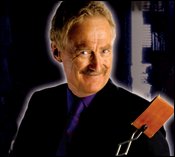
Theatrical pickpockets, con men seek to entertain and educate in …˜Hoodwinked’
Article in today’s Schenectady Daily Gazette

Article in today’s Schenectady Daily Gazette

Sandy and Frances thought little of the gaggle of girls who flopped onto the bench they were resting on. There were more girls than could fit on the bench: half a dozen or more. They were pretty, 15-16-year-olds and with them was an adult woman. Their teacher, perhaps, Frances thought.
The girls cozied up to Sandy, making room for one more to squeeze onto the bench. They wiggled and squirmed, like impatient students in class, while the woman spoke to them. Sandy and Frances didn’t understand the language they spoke.
The couple didn’t notice that all the other benches were empty. They didn’t wonder why this gang, or “class,” had to crowd onto their bench. They were not the least suspicious of the girls.
“Why don’t we move so they can all fit,” Sandy said after a couple of minutes. He and Frances settled on the next bench.
“We needn’t have bothered,” he said, watching as the group immediately left the bench and the area.
Londoners Sandy and Frances had just flown into Barcelona to take a cruise. They were too early to board, but it was a gorgeous, sunny afternoon and they didn’t mind waiting the ten minutes before the gangway opened.
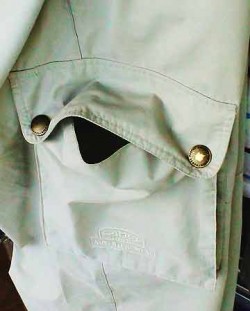
Soon they were in their stateroom, unpacking. Sandy opened a drawer to put away his wallet and, of course, you know: his pocket was empty. He’d had it in the cargo pocket of his pants, “secured” with two buttons. He told us how he went cold all over. How he checked and rechecked his pocket, not believing his wallet was really gone. But from the first instant, he knew exactly what had happened.
Are you groaning? Not another Barcelona story, please! I’m afraid so.
Sandy told us over and over how stupid he felt for letting it happen. There was a lot of money in the wallet, but his insurance would replace it. He just felt like an idiot. Although I’ve never heard of this particular technique, I assured him that this gang was well-practiced in the art of portraying innocence. They knew exactly how to behave, how to avoid rousing suspicion.
The thief hadn’t even unbuttoned the pocket. She didn’t need to. The gap between the two buttons was large enough for a slim hand and a wallet.
They got thousands of British pounds. I don’t think they’ll work for a while. We’re all safe from this gang, at least for the next week or two.

As a very frequent flyer, I can understand that 12,000+ laptops are lost each week in U.S. airports. What’s shocking is that, according to a study, only 33% of laptops that make it to lost-and-found are reclaimed. My first thought is: insurance fraud. Lose it, claim it, get a new machine.
The point of the study, though, is really data loss, theft, and abuse. Who cares about the hardware? Wouldn’t it be fascinating to know how many of those never-claimed laptops sitting in lost-and-found actually contain sensitive data? And when was the machine last logged into? After the loss?
Having lost a few precious things myself (a special scarf, an autographed book), I know how impossible it is to contact airport lost-and-found, and the runaround you get if you luck out and reach a human. “You have to contact the airline,” “just file a report online,” “the airline controls those gates,” etc. Hopeless.
And I hate to say it but, I’m convinced that airplane cleaners reward their thankless jobs by the old “finders keepers” law. How else to explain a book left between the window seat and the wall, gone without a trace five minutes after I disembarked? Losers weepers.

I just re-read the study, Ponemon Institute’s Airport Insecurity: The Case of Missing & Lost Laptops.
I had first read it back in July when its stats were thoroughly discussed on Schneier’s site. One of my own comments there is “no departments try to return property. Look at all the staffing cuts. Who’s the first to go? An individual might try to return something, but not a department. Even if you know you left something on a plane, even if you report it a minute after you get off, you can kiss it goodbye.”
Most laptops are lost at the security checkpoint—no surprise. People think the area is full of “security” personnel, and that makes their stuff secure. Many times, I pick up my own computer, then Bob’s. No one notices or cares that I picked up two machines. No one questions me whether I have two in my arms at once, or pack up mine and walk off with another.
While the report’s stats are interesting, I think the “Recommendations and Conclusions” are unrealistic. They suggest you allow enough time, as if you haven’t just run between terminals as fast as you can to make your “airline legal” but still-tight connection. They suggest you carry less; hey, we carry what we need, and what we don’t trust the airlines (or TSA) with in checked bags. They suggest you think ahead and have a mental strategy at security. That works—as long as you aren’t in a sleep-deprived fog from flying 14 or more cramped hours and now you don’t know if it’s morning or night. And as long as everything at the checkpoint goes smoothly, which is never certain. Someone cuts in front of you and delays you from getting to the other side, where your stuff sits vulnerable. A bossy TSA agent disrupts your strategy because he wants it done his way. TSA needs to rescan half your stuff and your items are spread out all over.
I have long had a strategy. I lay down my things—always the same things—in a strict order. This allows me to pick them up on the other side and reassemble everything quickly and logically. Every once in a while, that bossy TSA employee will rearrange my things, or hold back some of them in order to re-run someone else’s. This tampers with the otherwise reliability of my strategy.
I like two of the study’s recommendations. One is obvious, to label your laptop so you can be easily contacted. The other mildly recommends that airports make it easier for passengers to report losses. That would really help. Fat chance.
![]()

Last month in the New York Times, Michael Pollan wrote an open letter to the president-elect about the importance of revising our entire food policy. It’s a long letter, but I highly recommend it.
You can read his letter in The New York Times or on Michael Pollan’s website.
You can listen to Terri Gross interview Pollan about his letter on her NPR show, Fresh Air. It’s 40 minutes long.
Or you can download an MP3 of my computer reading Pollan’s letter. It’s 52 minutes of robot speech; a bit unpleasant at first, then no more irritating than reading text in a bad font. Not nearly as bad as reading reverse text (white text on a dark background). Listen carefully and you can even hear the robot take a breath at the beginning of sentences.
I’m trying to make it easy for you to ingest Pollan’s article.
After cars, the food system uses more fossil fuel than any other sector of the economy … chemical fertilizers (made from natural gas), pesticides (made from petroleum), farm machinery, modern food processing and packaging and transportation … [W]hen we eat from the industrial-food system, we are eating oil and spewing greenhouse gases. This state of affairs appears all the more absurd when you recall that every calorie we eat is ultimately the product of photosynthesis — a process based on making food energy from sunshine. There is hope and possibility in that simple fact.

Besides reverting to old-fashioned, clean, solar-powered farms, Pollan wants to see healthful food made affordable, nutrient-free junk food such as soda lose its “food” status, diversity in agriculture, crop rotation, feedlots opened up to the pastures, and much more.
Pollan’s core message is this: “we need to wean the American food system off its heavy 20th-century diet of fossil fuel and put it back on a diet of contemporary sunshine.” He acknowledges that this is a complex and gargantuan task. He has explanations and ideas for every aspect of feeding America, starting with the Farm Bill and ending with family dinners. It’s hopeful, and hopefully practicable.
Pollan questions some of the wacky food things we do now, such as shipping American raised salmon and chicken to China for cutting up, then shipping the raw stuff back to the U.S. to sell. And he’s got a few wonderfully wacky ideas of his own. For example, he’d like to see the White House front lawn replaced by a produce garden, the excess of which should go to a local food bank. And perhaps forgive culinary-school student loans if graduates cook and teach in public schools for a spell. And committing the White House to one meatless day a week which, he says, if all Americans did would equal taking 20 million midsize cars off the road for a year.

In his Fresh Air interview, Terri Gross asks Mr. Pollan if he heard from a representative of either candidate after the publication of his article. No, he answered, except that one of the campaigns’ transition teams (unnamed) asked if Mr. Pollan could provide a one- or two-page summary for them. He refused, saying “the reason I wrote 8,000 words is because that’s what I needed to tell the story. If I could have written it in one or two pages, I would have.”
Barack Obama refers to Pollan’s article in an October 18, 2008 interview for Time magazine and appears to take the issues to heart. Good sign. We’ll see.
Michael Pollan has been one of my favorite food writers since I read his article Power Steer in 2002. Now I urge you to read Farmer in Chief.
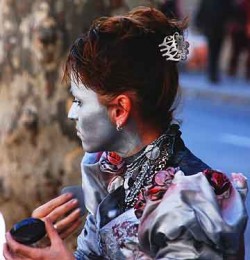
Adrian has been a living statue on Barcelona’s Ramblas for two years. He was a chef in Romania before, and part owner of a small hotel. But economic opportunities are greater for a statue; or they were, before major changes were instituted about two months ago.
No one needs a permit to be a statue on La Rambla, but there are rules and regulations. The statue must design and make an original costume. And the statue must be still, moving only to reward contributors to the hat.
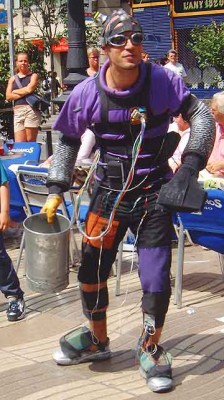
Performance artists are no longer allowed on La Rambla, because they often draw large crowds of spectators. The crowds attract pickpockets. Pickpockets can easily steal from a stationary, distracted victim who expects others to crowd in behind him.
This is a good theory, in general. In practice, many a performer fails to draw a crowd, and quite a number of statues have learned to do so. But there may be something to the new initiative.
It’s not a fair comparison, but I’ll compare anyway. In three days of walking La Rambla last week, Bob and I saw very few “suspects;” i.e., characters we deem worth watching due to suspicious behavior. Quite unlike our previous observations five months ago. See Barcelona Street Crime Today and the articles linked within it. Granted, it was pouring rain two of those days last week. The few brave souls out in the weather wore raincoats or jackets that made pocket access difficult. Anyway, the pickpockets stayed home. Not that rain always stops them! Our third day of tramping the tourist trail was mostly morning hours. This too, is not prime time for thieves.
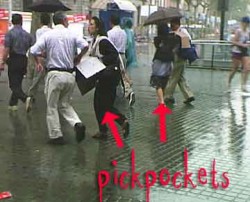
Even including a few afternoon hours, the avenida was quiet, perp-wise. Sure, the three-shell pea gamers were out, and we saw one pea crew under arrest, waiting for transport. But the population of thieves has moved on. Not far, I’m sure, but off the main drag.
And while the thieves are fewer on La Rambla, the living statues have proliferated. In some prime areas, near mcDonald’s, for example, and at the intersection of Portafarissa, barely six feet separate the statues from one another, six or seven of them in a row.
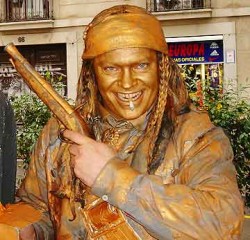
While some stand dejected, others have mastered a certain glint in the eye, a beckoning dare: “want to see what I do? Drop in a coin!” The plastic bottle man rarely stands still. The green fairy’s fingers are constantly coaxing passers-by nearer. The black horned creature has enormous curved wings, which he swivels to hide his face from photographers until he gets a coin. The toilet man makes faces. I’m pretty sure that the Michael Jackson statue is the same guy who used to do impressions at the bottom of La Rambla. He used to get huge crowds, and probably pretty good money. Now he stands frozen in costume, bucket begging, but not terribly enticing. His huge talent is wasted here. People walk on by.
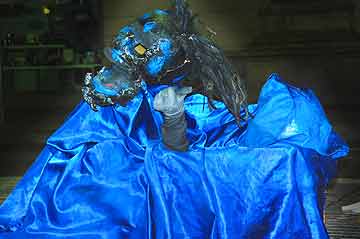
One creature, a strange head resting low in a pile of blue satin, manages to get huge audiences. Like a jack-in-the-box, the head pops out of the fabric with a a growl and a shout, its single hand gesticulating wildly. The crowd screams and backs up, leaving a wide berth around the unpredictable danger. Strange, since it’s fairly obvious that the performance artist is crunched up in a box, non-ambulatory. Anyway, the spectators’ noisy appreciation attracts others to the circle, and the crowd grows.
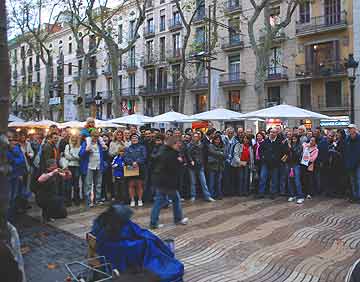
The difference between the large crowd surrounding the head-in-the-box, and the crowd that surrounded the Michael Jackson impersonator, is an important one to the pickpocket. The head-in-the-box has a limited repertoire, and therefor cannot hold a crowd. Michael Jacksonesque performed many songs, holding his audience and giving the pickpockets plenty of time to select a mark and do their dirty work.

Adrian, who stands statue-still then poses for pictures for whatever coin he’s thrown, is in one of those concentrated rows of statues. Beside him is a magician, from Romania, like Adrian. The magician, wearing an ordinary black suit and white shirt, has a bit of a crowd around him. He’s performing with a trick rope, a black-covered book under one arm. He appears nervous, looking up and down the street. When he suspects police are near—perhaps he’s signaled by someone—he steps onto a small, low platform, flips open his book, and stares at it. Poof: a statue.
Adrian’s disgusted by the magician’s cheating way. He empties the small coins from his money-box as he complains about his neighbor. He says the tricks are lousy, just purchased things, performed without soul. Yet the magician gets crowds and Adrian doesn’t. Adrian tips his box and I see that a few one- and two-euro coins are glued to the bottom.

Adrian claims to get eight to 15 euros in his best hours. The magician gets more, he admits, and that makes Adrian mad. Still, he works the hours he wants to work, takes off when it suits him, and is able to send money home to his wife and two daughters.
It’s easy to see that the most interactive statues, those with the best costumes, those whose photos are most sought, make more money than the passive ones. Adrian said the best make 40 to 50 euros in a good hour.
The clowns make even more: 50 to 60 euros per performance for the best one, according to Adrian. Of course they no longer work on La Rambla either.
The city seems to be on to something. Or maybe it’s just a temporary lull. Time will tell. Bob and I will report later.
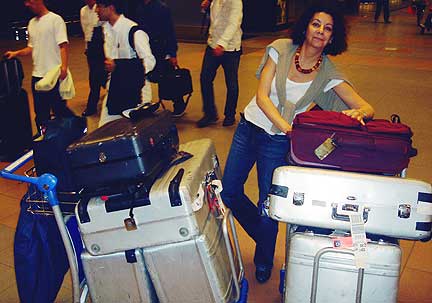
For very frequent travelers, the right luggage is vital. Bob and I have used aluminum Zero Halliburton luggage forever. It’s heavy and expensive. It gets dented and full of stickers. Every few trips, a bag loses a handle or a wheel, and we keep on repairing them. We can’t even take advantage of their good locks anymore. Instead, we wrap strong tape around the seams to thwart thieves.
In iffy hotels we use one of these as a safe for small valuables, sometimes even laptops. The theory is that a camera, passport, maybe even a laptop can “get legs.” A large, heavy suitcase is less likely to go missing.
Bob uses a black aluminum Halliburton roll-aboard. It’s strong, padded, and lockable, so he’s not worried when his carry-on must be put in a plane’s cargo hold, no matter what’s in the bag. You can see it on the top of the left stack in the photo. This clamshell-type roll-on does not suit me at all. I like lots of zipper compartments, so I can easily grab my computer power cord, a book, or a document from a file folder. I also like a roll-on big enough to neatly carry an outfit or two. These are usually called one-suiters. I always have one suit and one stage dress in the roll-on. I’ve been without my checked luggage one time too many.
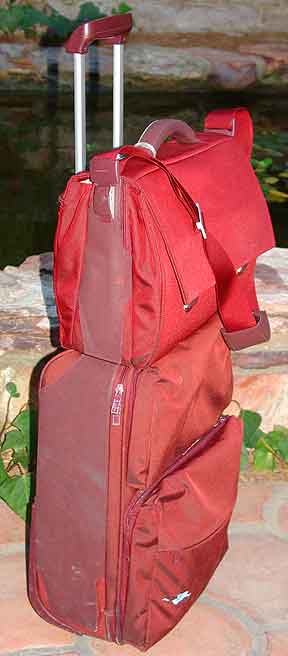
My roll-on has a matching shoulder bag which stacks easily and securely. And of course it has a shoulder strap for the millions of stairs that require hauling instead of rolling. The shoulder strap attaches with a ridged plastic tab. This was my biggest concern when I bought this combo three-plus years ago. What if it comes loose? My laptop is in the shoulder bag, my iPod, passport, a little camera, and all my most important things. Many a time I have boarded rickety boats with this bag on my shoulder. But I’ve come to trust it.
The plastic tab broke on the way to Oman recently. The day I got home I photographed the strap and sent it to the company. In a week, I had a new strap, overnighted from Italy, no charge. So I think I should mention that my carry-on luggage is made by the Italian company, Mandarina Duck.
![]()

Why did we order two?
Paper masala dosa is one of my favorite meals. I order them at every opportunity when I’m in India, Singapore, or Dubai. It was a restaurant in Phoenix, though, where I was served the biggest one I’d ever seen.
Dosas are hard to find in the U.S., but I discovered Udupi in Phoenix, where they serve 17 kinds. 16 kinds I don’t care about. It’s paper masala dosa, every time. I dream of its shiny mahogany surface complete with streaky tracks from the dosa-maker’s spatula, the intoxicating fragrance of ghee, and the traditional accompaniments. I like the drama of its arrival, even when it isn’t this gargantuan; even when I fetch it from the grill myself. And I like the eat-it-while-it’s-hot urgency, even though it’s impossible to eat it while it’s hot.
Paper dosa is a thin, crisp pancake made from a fermented batter of rice and lentil flour. They’re always large, but I’ve never before come across the three-foot long version. Then again, I’ve never before been to Udupi—the restaurant, or the city in southern India.

A paper dosa always comes with a little bowl of sambar (a thin tomatoey broth) and two fresh chutneys. Indian chutneys are not the sweet-hot preserved fruit bits in jars, as sold in U.S grocery stores. Those are “pickles.” Chutneys are fresh. With a paper dosa, you get one of ground coconut mixed with chilies and fresh green coriander or mint leaves, and one other, complimentary chutney (the kind varies).
If you order paper masala dosa, your dosa is rolled around a ladle of potato-onion curry, and the meal becomes hearty. They are always too much for me, but this one was amusing in its hugeness. It was no joke, though.

Indian restaurants are everywhere now; unfortunately, they all seem to have the same predictable menus: butter chicken, chicken tikka, lamb korma, beef vindaloo, aloo gobi… They’re all north Indian restaurants and they all must use the same boring, failsafe recipes. If you’ve never had the cuisine of south India, it’s worth seeking out. You’ll get dosas (maybe 17 kinds!), other unfamiliar crepes, pancakes, and “donuts,” and dishes rich with coconut and chilies.
Udupi Cafe
1636 N Scottsdale Road
…¨Tempe, AZ 85281 …¨
Phone: 480-994 8787
![]()
I started talking about Consular Information Sheets here.
Odd but possibly vital information can be found in the Consular Information Sheets regularly posted by the U.S. Department of State [D.O.S.]. For example:
“It is illegal to bring into Japan some over-the-counter medicines commonly used in the United States, including inhalers and some allergy and sinus medications. Japanese customs officials have detained travelers carrying prohibited items, sometimes for several weeks. Some U.S. prescription medications cannot be imported into Japan, even when accompanied by a customs declaration and a copy of the prescription.”
Staggering advice! But the report doesn’t stop there. It includes links to English-language Japanese sites with prescription look-ups, because “Japanese customs officials do not make on-the-spot …˜humanitarian’ exceptions.”

In a recent Peru information sheet,
“Travelers are advised to seek advice from local residents before swimming in jungle lakes or rivers, where alligators or other dangerous creatures may live. All adventure travelers should leave detailed written plans and a timetable with a friend and with local authorities in the region, and they should carry waterproof identification and emergency contact information. … Peruvian customs regulations require that many electronic items or items for commercial use be declared upon entering the country. Failure to make a full and accurate declaration can lead to arrest and incarceration.”
Better mention your laptop or digital camera.
If you “get sand in your shoes,” that is, fall in love with island life on your Bahamian vacation, you’ll be glad to have read that
“U.S. citizens should exercise caution when considering time-share investments and be aware of the aggressive tactics used by some time-share sales representatives. Bahamian law allows time-share purchasers five days to cancel the contract for full reimbursement. Disputes that arise after that period can be very time-consuming and expensive to resolve through the local legal system.”
Going to see the pyramids of Giza and Cairo’s exotic Khan el Khalili bazaar? The U.S. D.O.S. tells us that
“Egypt is one of the world’s leaders in fatal auto accidents. Traffic regulations are routinely ignored. If available, seatbelts should be worn at all times. … Sidewalks and pedestrian crossings are non-existent in many areas, and drivers do not yield the right-of-way to pedestrians.”

Knowing this will certainly alter your behavior whether driving, taxiing, or walking in Egypt.
The U.S. Department of State isn’t in the scare business. Each of its reports is rich with phone numbers and links to official websites to help travelers get the information they need. Instruction is included on how to deal with problems and emergencies while abroad, including after-hour phone numbers. The State Department’s information is invaluable, available via phone, fax, pamphlet, and internet; and free.
U.S. Department of State
Bureau of Consular Affairs
Washington, DC 20520
For recorded travel information, call 202-647-5225
For information by fax, call 202-647-3000 from your fax machine
www.travel.state.gov
Excerpt from Travel Advisory: How to Avoid Thefts, Cons, and Street Scams
Chapter Two (part-c): Research Before You Go
![]()

There was plenty of clowning around in Muscat last week. In the souk, Bob put a camera on a tripod and walked away from it. We wouldn’t do that in most of the places we visit, including other countries under strict Sharia law. But this Omani souk, crowded with locals, had a comfortable, family atmosphere.
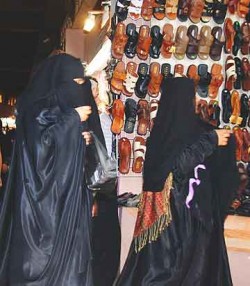
Bob held a remote and snapped a few test shots. Without warning, this happy man danced into our shot. These two women also stepped in front of the shutter. A large number of women were completely covered, not even eye slits in their black face veils. Some wore sunglasses on top of full face veils.
I understand that Muslim women must cover themselves, but in 110 degree heat, their multiple layers must be torture. Bob was drenched in a loose, light-as-air shirt. I was hot in my two skimpy layers.

The local women wore long pants and long sleeves under their abayas and veils, and some wore scarves, too. Omani women wear very long abayas, “taller than themselves,” a custom which dates back to their Bedouin days, when even a woman’s footprints in the sand should not be seen. The long gown gracefully erased them. Omani men wear a tassel at the neck of their dishdasha, which is drenched in scent to enhance male-to-male hugs.

Bob plopped down among a group of men who happily gave permission to be photographed, despite their dubious expressions here. Turns out they were right to doubt the intentions of the tall skinny Western man with unseemly bare legs.
It wasn’t long before Bob had the watch of one of the men. After a suitable moment of laughter from the others, Bob returned the watch and was admonished with a smile.

I’m happy to report that Bob left town with both hands intact.
At the Muscat airport, we had to sit in the lobby an hour, waiting for check-in to begin. We found chairs in a “family section,” which was filled mostly with women (about 30) and small children, and a few couples. About half the women were fully covered; meaning, not even eyes showing. The rest were bare-faced or only eyes showing, plus one Indian in a sari, and one Muslim nanny in an ordinary headscarf. I watched the little children run around, ages 2 to 6, and wondered how they identified their mothers. The women had no peripheral vision; I wondered if they can even see to step off a curb.

High-end shops are popular in the Arab world. Women buy the latest Prada and Versace outfits, then cover them with abayas. At social gatherings, the women gather in a private room and remove their abayas.

Example of a journey that did not go smoothly.
1. Taxi was late picking us up at home.
2. Taxi reeked of cigarette.
3. Taxi broke down, but limped into the airport. (Driver had to be picked up from the airport.)
4. Virgin Atlantic was unable to check us in. (Travel agent did something wrong in ticketing.)
5. Travel agent couldn’t be reached for about an hour. Almost too late, but not quite.
6. Due to ticketing anomalies, our luggage could only be tagged and checked through to London, forcing us to pick them up and re-check them there.
7. All four of our suitcases were marked for “random” searching.
8. The security tape we put on our suitcases was removed by TSA, making the contents vulnerable for the rest of the journey.
9. Power outlet at Las Vegas airport was dead but I didn’t notice and completely drained my computer battery.
10. Had to go through immigration and customs in London in order to re-check the bags.
11. Emirates Airlines at Gatwick could only tag bags as far as Muscat.
12. No lounge access at Gatwick. (Emirates Air no longer allows Star Alliance Gold members.)
13. Exit row seats promised on Emirates are not exit row. Plus, someone else is assigned to the same seats we are. (Fixed: exit row seats had been assigned properly, but boarding passes were printed incorrectly.)
14. Couldn’t check email in Dubai, computer battery dead. (Could have charged computer on the London-to-Dubai flight, but I was too tired to deal with it.)
15. Same problem with seats Dubai-to-Muscat. (Eventually resolved.)
16. Had to buy visas in Muscat just to collect and re-check luggage to Salalah (Oman).
17. Shoulder strap of my heavy carry-on bag broke. Must hand-hold from now on.
18. Driver in Salalah had too small a car for us plus luggage. Called for another car. Waited half an hour.
19. At maritime immigration office, officer could not find Oman visas in passports. Waited an hour while he and four others flipped through our many passport pages. (Eventually resolved.)
20. Driver’s car got flat tire. Had to wait for another car and transfer everything.
After 37 hours, we and all our luggage arrived safely. Not too bad, really; just exhausting.
![]()